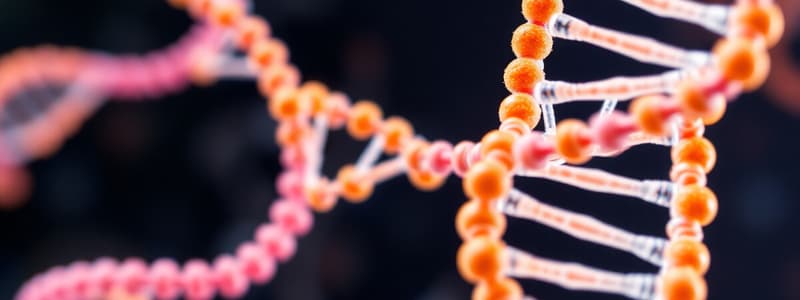Podcast
Questions and Answers
What sugar is contained in RNA?
What sugar is contained in RNA?
- Fructose
- Ribose (correct)
- Deoxyribose
- Glucose
Which nitrogenous base is found in RNA instead of DNA?
Which nitrogenous base is found in RNA instead of DNA?
- Thymine
- Cytosine
- Uracil (correct)
- Adenine
What is one of the primary functions of nucleic acids?
What is one of the primary functions of nucleic acids?
- Regulation of hormones
- Cellular respiration
- Storage and transmission of genetic information (correct)
- Energy storage
Which of the following correctly describes a property of nucleic acids?
Which of the following correctly describes a property of nucleic acids?
Which of the following is a primary role of messenger RNA (mRNA) in translation?
Which of the following is a primary role of messenger RNA (mRNA) in translation?
What distinguishes DNA from RNA at the base pairing level?
What distinguishes DNA from RNA at the base pairing level?
What distinguishes RNA from DNA regarding stability?
What distinguishes RNA from DNA regarding stability?
What is the first step for naming nucleotides as ordinary compounds?
What is the first step for naming nucleotides as ordinary compounds?
What is the chemical composition of nucleic acids primarily made up of?
What is the chemical composition of nucleic acids primarily made up of?
How does the structure of DNA differ from that of RNA?
How does the structure of DNA differ from that of RNA?
How is ribosomal RNA (rRNA) primarily involved in cellular processes?
How is ribosomal RNA (rRNA) primarily involved in cellular processes?
What is the correct conversion from 'cytidine' to its corresponding acid form?
What is the correct conversion from 'cytidine' to its corresponding acid form?
Which statement accurately reflects the solubility properties of nucleic acids?
Which statement accurately reflects the solubility properties of nucleic acids?
Which of the following statements is NOT true regarding RNA and DNA?
Which of the following statements is NOT true regarding RNA and DNA?
Which of the following correctly describes the helical structure of nucleic acids?
Which of the following correctly describes the helical structure of nucleic acids?
Who first recognized and identified DNA?
Who first recognized and identified DNA?
Which sugar is present in the structure of DNA?
Which sugar is present in the structure of DNA?
What is the common characteristic of A-DNA and B-DNA forms?
What is the common characteristic of A-DNA and B-DNA forms?
Which base pair is not correctly matched?
Which base pair is not correctly matched?
What distinguishes Z-DNA from A-DNA and B-DNA forms?
What distinguishes Z-DNA from A-DNA and B-DNA forms?
What is the correct name for the nucleoside cytidine when converted to an acid form?
What is the correct name for the nucleoside cytidine when converted to an acid form?
Which component of ATP provides it with high energy bonds?
Which component of ATP provides it with high energy bonds?
Which nucleoside is paired with its correct acid form?
Which nucleoside is paired with its correct acid form?
Which of the following represents a common nucleotide in RNA?
Which of the following represents a common nucleotide in RNA?
What component is NOT part of a nucleotide?
What component is NOT part of a nucleotide?
Which sugar is found in RNA nucleotides?
Which sugar is found in RNA nucleotides?
What process is ATP primarily involved in within a cell?
What process is ATP primarily involved in within a cell?
To convert a nucleotide into its corresponding acid form, which suffix should be used?
To convert a nucleotide into its corresponding acid form, which suffix should be used?
What process connects nucleotides to form a polymer?
What process connects nucleotides to form a polymer?
Which of the following nitrogenous bases is ONLY found in DNA?
Which of the following nitrogenous bases is ONLY found in DNA?
Which of these is NOT a common nucleotide found in DNA?
Which of these is NOT a common nucleotide found in DNA?
What links the sugar of one nucleotide to the phosphate group of another nucleotide?
What links the sugar of one nucleotide to the phosphate group of another nucleotide?
What sugar component is found in ATP?
What sugar component is found in ATP?
What is the primary function of nucleic acids?
What is the primary function of nucleic acids?
How are nucleotides named when attached to a phosphate group?
How are nucleotides named when attached to a phosphate group?
Which of the following represents a nucleotide structure?
Which of the following represents a nucleotide structure?
Which of the following statements about nitrogenous bases is true?
Which of the following statements about nitrogenous bases is true?
What is formed when nucleotides are linked together?
What is formed when nucleotides are linked together?
What is the role of the nitrogenous base in nucleotides?
What is the role of the nitrogenous base in nucleotides?
Which of the following combinations of nucleotides correctly represents the basic components?
Which of the following combinations of nucleotides correctly represents the basic components?
Flashcards are hidden until you start studying
Study Notes
Biological Significance of Nucleic Acids
- Essential for the storage and transmission of genetic information.
- Crucial for synthesizing proteins that characterize individual cells.
Properties of Nucleic Acids
- Insoluble in alcohol.
- Slightly soluble in cold water; easily dissolves in hot water and dilute alkalis, forming alkali salts.
- Can be precipitated by hydrochloric acid (HCl) and excess acetic acid (CH₃COOH).
Types of Nucleic Acids
- Comprised of carbon (C), oxygen (O), hydrogen (H), nitrogen (N), and phosphorus (P).
- Two primary types:
- RNA (ribonucleic acid)
- DNA (deoxyribonucleic acid).
DNA vs RNA
- Both DNA and RNA are built from nucleobases.
- DNA contains thymine while RNA contains uracil.
- DNA consists of deoxyribonucleic acid; RNA consists of ribonucleic acid.
- The presence of a hydroxyl group at the 2' position of ribose differentiates RNA from DNA.
- Both nucleic acids have a helical structure with sugar-phosphate backbones on the outside.
RNA Characteristics
- RNA is typically single-stranded and less stable than DNA.
- Functions mainly to regulate protein synthesis.
- Contains the sugar ribose and nitrogenous base uracil instead of thymine.
Nucleotide Composition
- Composed of three parts: a phosphate group, a five-carbon sugar, and a nitrogenous base.
- Common nucleotides in RNA include cytidine monophosphate (cytidylic acid) and uridine monophosphate (uridylic acid).
Roles of RNA in Translation
- mRNA (messenger RNA): Carries instructions for polypeptide synthesis from nucleus to ribosomes.
- tRNA (transfer RNA): Brings amino acids to the ribosome and matches them with the corresponding mRNA code.
- rRNA (ribosomal RNA): Integral part of ribosome structure.
Naming of Nucleotides
- As compounds: Name the nucleoside and attach "monophosphate" (e.g., cytidine 5' monophosphate).
- As acids: Change ending of nucleoside from -ine to -ylic and add "acid" (e.g., cytidilic acid).
Common Nucleotides
- RNA: Cytidine monophosphate (cytidylic acid), uridine monophosphate (uridylic acid), adenosine monophosphate (adenylic acid), guanosine monophosphate (guanylic acid).
- DNA: Deoxycytidine monophosphate (deoxycytidylic acid), deoxyuridine monophosphate (deoxyuridylic acid), deoxyadenosine monophosphate (deoxyadenylic acid), deoxyguanosine monophosphate (deoxyguanylic acid).
ATP (Adenosine Triphosphate)
- Composed of adenine (nitrogenous base), ribose (sugar), and three phosphate groups.
- Functions as a primary energy source for cells, acting as a temporary energy battery.
DNA Structure
- Recognized by Johannes Friedrich Miescher in 1869.
- Comprises two strands forming a right-handed double helix, held together by hydrogen bonds.
- Base pairing occurs between guanine-cytosine and adenine-thymine.
- Sugar in DNA is deoxyribose.
DNA Forms
- A-DNA: Right-handed double helix.
- B-DNA: Most common conformation, also right-handed.
- Z-DNA: Left-handed double helix with a zig-zag pattern.
Chromosomes and Genes
- Human genome contains 46 chromosomes (23 from each parent).
- Chromosomes consist of DNA coiled around proteins, termed nucleosomes.
- Genes serve as individual instructions for cell function, with introns being removed from pre-mRNA during processing to form usable mRNA.
Studying That Suits You
Use AI to generate personalized quizzes and flashcards to suit your learning preferences.




